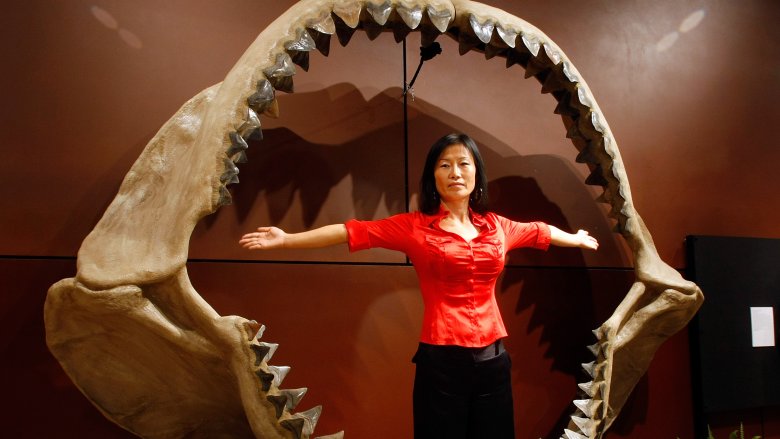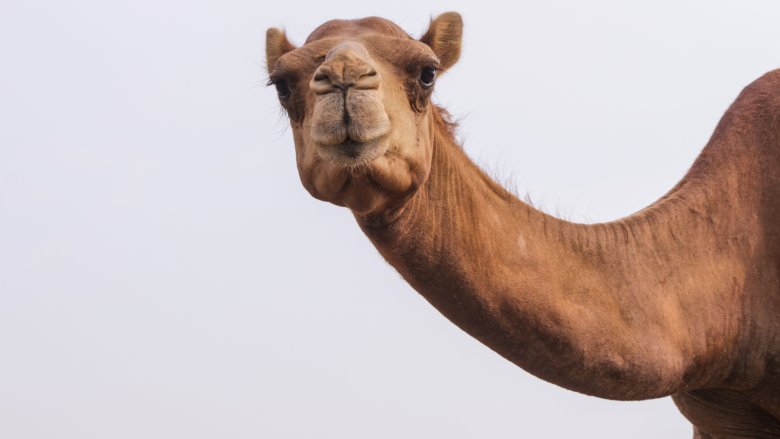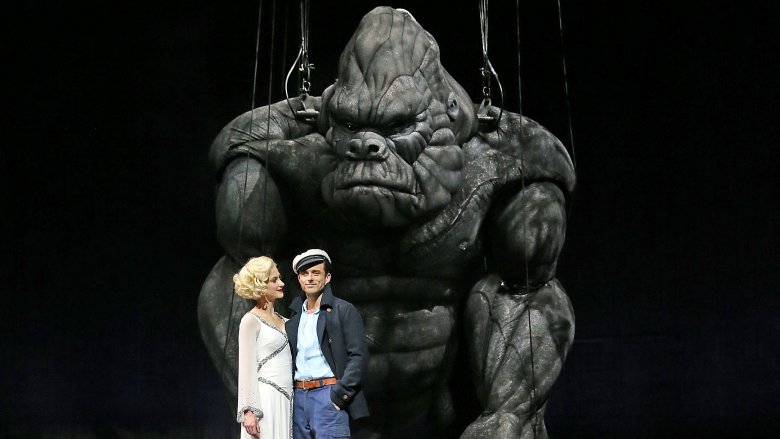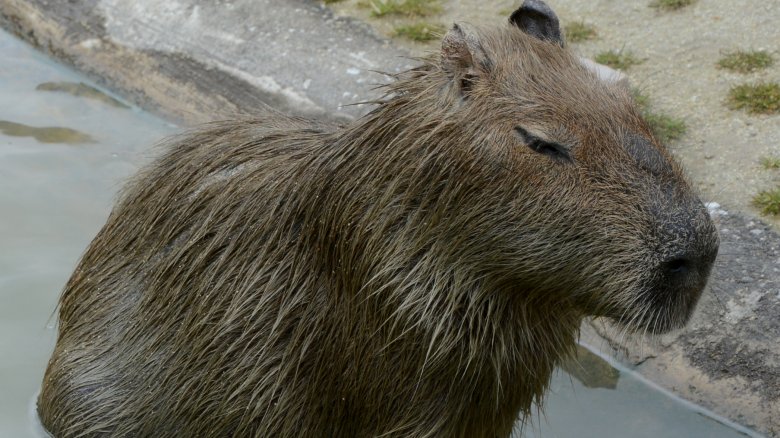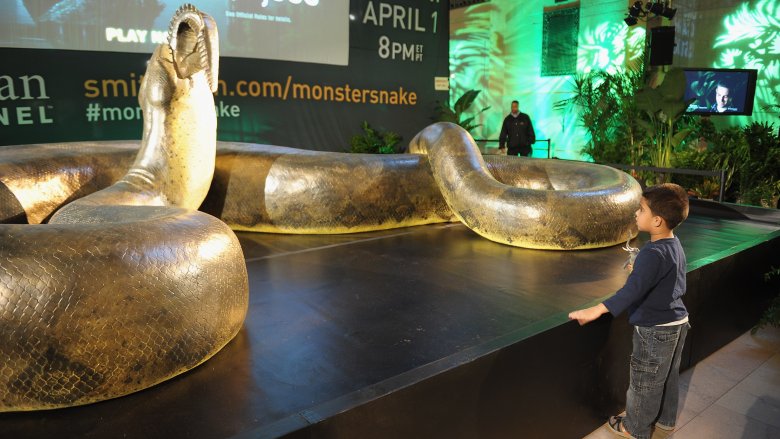Everyday Animals That Were Terrifyingly Big In Prehistoric Times
Life in the 21st century is hard enough, but just imagine how much more stressful your commute would be if you had to speed past Incredible Hulk-sized "terror birds" trying to flip over your car, or if your windshield kept getting smeared with the remains of insects bigger than volleyballs. Suddenly traffic jams don't seem so bad, right?
These days, most animals you encounter tend to be on the smaller side. Sure, there are notable exceptions, such as elephants, giant squids, and that insanely enormous blue whale. However, back in the good old days of yore — you know, the millions of years before human civilization dominated the globe — the ancestors of today's animals grew to proportions so monstrously enormous that even Indiana Jones might faint. Get ready to see all your favorite animals in a whole new light.
Sloths were bigger than elephants
Everyone loves sloths, those designated couch potatoes of the animal kingdom. Sure, they've got some mean claws, but they're so small, slow-moving, and relaxed that you wouldn't be surprised to find one smoking a joint. However, BBC shows that back in prehistoric times, the forests were prowled by so-called "giant ground sloths," also known as Megatherium, which were huge enough to take down any woolly mammoth that gave them a mean look. At least they were still vegetarians. Phew.
Today's sloths cling to tree branches, but their 20-foot-long ancestors wandered around on four legs, occasionally standing upright in order to rip down any tree branches they felt like snacking on, according to Mental Floss. These ancient ground sloths were so different from their contemporary great-grandchildren that when Thomas Jefferson studied one of their fossils, he determined it was a big cat of some sort. Even weirder, there was a species of giant sloth called Thalassocnus that dove underwater for food. If a giant ground sloth got into a fight, it was protected by armored plates on its back, neck, and shoulders, reminiscent of an armadillo.
Giant ground sloths managed to survive for a surprisingly long time, according to National Geographic, as there's evidence the last ones were still strolling down the beaches of the Caribbean a mere 4,500 years ago.
Camels that were 12 feet tall
Camels are already massive creatures, like mammalian dinosaurs, and they have a massive personality to match. However, about 100,000 years ago, the Independent reports that some camels were a whole lot bigger. The "Syrian camel," which wandered the grounds of present-day Syria, stood at a staggering 12 feet tall ... which means that, yeah, it was about the size of an African elephant, or almost twice the size of today's camels. If a regular camel is a "ship of the desert," then a Syrian camel was the Titanic.
As it happens, Syrian camels actually weren't desert creatures because the area of Syria they wandered around in is believed to have been savanna grassland at the time. It's unknown why or how the Syrian camels died out, though early humans may have hunted them into extinction. Regardless, it's interesting to imagine an alternate reality timeline where Syrian camels still existed and were, like their smaller descendants, domesticated. Just imagine a Sahara desert sunset, with those distinctive orange sand dunes populated by people riding on the humps of elephant-sized camels.
Crocodiles that could swallow a human in one gulp
All of us hairless apes might think we're at the top of the food chain, but let's face it, the biggest badasses on Earth are definitely scaly crocodilians. Although a Vice article claims they're basically ageless wonders, other researchers say that's an exaggeration. Still, they can live 70 to 100 years and are seriously fearsome as soon as their teeth get sharp. It's no wonder that these mighty beasts have shined their grinning mouthfuls of sharp teeth upon countless arrays of weaker animals (you know, like us) for millions of years. After all, crocodiles swam with dinosaurs, and they're still swimming today.
However, crocodiles have experienced some evolutionary changes since they first appeared on Earth. Specifically, these huge prehistoric animals have gotten a lot smaller. For example, the ancient crocodile Machimosaurus rex, an ocean-dwelling species described here by National Geographic, had a powerful body over 30 feet long. If that sounds like one big crocodile, well, prehistoric freshwater crocs like Sarcosuchus imperator grew to a jaw-dropping 40 feet, about the length of an average bus. According to Newsweek, these colossal crocodiles had teeth comparable to those of a Tyrannosaurus rex, and their heads stretched over 5 feet long. Just imagine the nightmares one of these crocs would have given Captain Hook.
Beavers the size of a black bear
Today, there are only two species of beavers remaining in the world, but according to the BBC, prehistoric beavers used to come in all shapes, sizes, and varieties. Beavers have always been impressive engineers, and the beavers of ancient times dug fascinating spiral burrows into the ground using their teeth. And repeatedly chomping down on dirt sounds a lot less pleasant than using a shovel, so you've got to give them credit for dedication. Out of all these old school beaver varieties, the Goliath of the beaver population was a creature called Castoroides, which scientist William Korth describes as "a beaver on steroids." Your average Castoroides was about 10 feet long and weighed almost 500 pounds, with giant teeth about as long as bananas.
The tail of a Castoroides was less paddle-like than the tails we see on beavers today, but these ancient, big prehistoric animals were probably fantastic swimmers. There's also evidence that these big ol' beavers may have built dams similar to the ones their descendants would one day be famous for. Castoroides died out about 10,000 years ago, leaving us with the little beavers we know today.
Bugs that were the size of birds (or bigger)
If insects and arachnids give you the willies, look away now. That "clock spider meme" might've been creepy enough, but there was a time when just about any bug, from flies to cockroaches, was too big for a flyswatter to handle, according to National Geographic. For example, while real dragons probably never existed, the skies of Earth were once dominated by giant dragonflies, who boasted wingspans equal to that of a seagull. Seriously, take a second to imagine seeing that perched on your window. Meanwhile, CNN reports that 6-foot-long scorpions were creeping along the ocean floor about 5 million years ago, snapping their enormous claws at anything stupid enough to get in their way.
The award for ultimate arthropod of all time probably goes to Arthropleura. According to paleontologist Hans-Dieter Sues, Arthropleura was very similar to present-day millipedes, except it was over a foot wide with an armored serpentine body that extended over 6 feet. Luckily, if Arthropleura's habits resembled those of the millipedes we know today, it probably only snacked on dead plant matter. Nonetheless, it's surprising that some aspiring horror director hasn't yet made a horror movie featuring these many-legged creatures developing a taste for humans.
Gigantopithecus, the real-life Sasquatch
Even our own simian relatives once put us to shame, according to National Geographic. Gorillas might seem pretty big, but they had nothing on Gigantopithecus, an ancient ape that stood 10 feet tall and weighed over 1,000 pounds. These guys were about the closest you could get to a real-life King Kong. Gigantopithecus lived in what is now China, but it died out about 100,000 years ago, probably because its massive size came with — you guessed it — a massive appetite. If only lasagna dinners had been invented a few millennia earlier, maybe things could've been different.
However, according to the Smithsonian, plenty of cryptozoology enthusiasts have theorized that some Gigantopithecus might secretly still be alive today. Where are they hiding? Well, if you find one in the North American woods, you'd call it "Bigfoot," and if it's climbing the Himalayas, it's a "yeti." If the infamously unproven ape-man is really out there, it would make sense that he'd be a Gigantopithecus. But until some sort of incontrovertible proof arrives, we'll have to chalk this one up as one of the many interesting Bigfoot theories out there.
A shark that could eat today's sharks for breakfasts
Probably the most terrifying creature to ever swim in the ocean was megalodon, a shark so enormous it could swallow a great white in one gulp. According to National Geographic, megalodon means "giant tooth," which is a fitting name for an animal with jaws powerful enough to crush an automobile. Megalodon was about 50 feet long, and shark expert Dr. Peter Klimley has explained that, "A great white is about the size of the clasper, or penis, of a male megalodon." Thanks, Doc.
Since tasty human divers weren't splashing around 10 million years ago, it's theorized that megalodon instead satisfied its voracious appetite by eating live whales. Despite being so powerful, megalodon went extinct about 2 million years ago, perhaps due to a combination of cooling waters and competition from more social predators like orcas.
As with Gigantopithecus, some believe these giant sharks still prowl the waters today. According to Time, this is because in 2013, the Discovery Channel aired a sci-fi mockumentary titled Megalodon: The Monster Shark That Lives. Understandably, 79 percent of viewers came out of this broadcast believing the colossal sharks were still alive, and the network subsequently earned major criticism from shark experts. For what it's worth, there's still no convincing evidence that the ocean we know today is holding any sharks even half the size of a megalodon.
Super salamanders with toilet-like mouths
The term "dinosaur" is Greek for "terrible lizard," but as any dinosaur-loving second grader will tell you, dinosaurs weren't lizards. Neither are salamanders, though these amphibious creatures are often confused for a lizard, despite the fact that they're more closely related to frogs. Lizard or not, today's salamanders tend to be cute little critters, but 200 million years ago, Earth's waters were the home of a 6-foot-long salamander, whose head was the size of a coffee table. According to paleontologist Stephen Brusatte, this amphibian was called Metoposaurus algarvensis, or as he puts it, "the super salamander that nearly ate your ancestors for breakfast."
According to the Journal of Vertebrate Paleontology, the Metoposaurus lived in the Triassic period alongside the dinosaurs, but it died off before they did. Though these super salamanders were only around for a relatively short time, they were quite interesting creatures, possessing wide, flat heads that opened and closed much like a toilet seat. Maybe that's where the phrase "potty mouth" came from.
'Rats' that could've charged a bull
Yeah, that's right. Not only were bugs once the size of house cats, but some rodents were even bigger. Anyone who felt traumatized by the 1959 B-horror film Killer Shrews (which was probably no one, considering the film was goofy enough to earn a spot on Mystery Science Theater 3000) would not be happy to learn about the existence of Josephoartigasia monesi, the so-called "fossil rat" from present-day South America. Despite this nickname, these "rats" more closely resemble today's capybara, a South American animal which is the largest living rodent in the world.
According to National Geographic, these sharp-toothed fossil rats could've trampled right over any capybara today, considering they were bigger than a bull and weighed over 2,000 pounds. Though J. monesi's tiny molars have led researchers to believe they were probably herbivores that fed on aquatic plants, the animals also possessed some seriously deadly incisors that could easily fend off attackers. So while those wisecracking robots Tom Servo and Crow T. Robot might've laughed off those "killer shrews," they'd probably want to steer clear of the real-life version.
Snakes that were as long as a school bus
Probably every millennial kid suffered from nightmares after they watched an enormous prosthetic snake swallow Jon Voight in the 1997 thriller Anaconda, which went on to inspire four lesser-known sequels. Real-life anacondas don't get quite so enormous, but 58 million years ago, the tropical jungles of Colombia were home to an even bigger snake called Titanoboa cerrejonensis. According to the Smithsonian, the fossil evidence of Titanoboa reveals a snake that grew to over 40 feet long, and weighed over 2,000 pounds.
To get a sense of just how big this snake's girth was, imagine it slithering in front of you, and imagine that the tallest part of its legless body was about as high as a human waist. Get the picture? Needless to say, Titanoboa could eat just about any other animal it wanted to, with the LA Times counting crocodiles (as seen in the sculpture above) and giant freshwater turtles among its favorite dinners. It's believed these enormous serpents saw their demise due to changing climates.
Giant, flightless, big-headed 'terror birds'
No, we're not talking about dinosaurs. Tyrannosaurus rex is certainly one fearsome grandpa, but birds have another ancestor who might've been even more horrifying. Meet the rampaging, flightless giant we now call the "terror bird," according to the BBC. Imagine if a mad scientist fused the DNA of an ostrich and a vulture, then tinkered with the genes until the creature's head was disproportionately huge and its body was 10 feet tall, and you'll get an idea of just how scary these terror birds really were. One of the most powerful carnivores in Earth history, these huge prehistoric animals are often depicted cawing with glee as they devour everything from horses to wolves to saber-toothed cats. Based on the behavior of the terror bird's descendants, it's believed these avian carnivores may have attacked prey by picking it up and repeatedly smashing it against hard surfaces, breaking the bones. Sounds painful, but it gets worse: In case you were hoping these creatures were the heavy lumbering type, National Geographic reports they were actually fast-moving and agile. Yikes!
Anyhow, terror birds killed and ate everything in their path for almost 60 million years before dying out a mere 2.5 million years ago. Honestly, if they were alive today, it's hard to imagine humanity would've ever survived.
